Porous Structure of β-Cyclodextrin for CO2 Capture: Structural Remodeling by Thermal Activation
Abstract
1. Introduction
2. Results and Discussion
2.1. Thermal Activation Process
2.2. Thermochemical Characteristics
2.2.1. Gas Product
2.2.2. Solid Product
2.3. Structural Remodeling
2.3.1. Fracture Process of Glycosidic Bond
- Homogeneous cleavage of C1’-O bond: since there is no saddle point on the potential energy surface, it is difficult to determine the transition state of the homolytic reaction, and the bond dissociation energy (BDE) is generally used as the activation energy for such reactions. The BDE equation of cracking reaction is listed as the following equation:where H(A − B), H(A) and H(B) are the enthalpy values of the molecules A − B and the free radicals A and B generated by its fracture, respectively. The calculated energy barrier of this path is 343.9 kJ/mol.
- C4-O bond cleavage: the energy barrier is 341.3 kJ/mol.
- Isocracking of C4-O bond: due to the electronegativity difference between carbon atom and oxygen atom, the possible position of glucosidic bond is the same as that of homolytic reaction. The calculation method of activation energy is the same as that of homolytic reaction, and the energy barrier of this reaction path is 357.5 kJ/mol.
- Heterosis of C1’-O bond: energy barrier is 498.8 kJ/mol.
- Synergistic reaction mechanism: in this path, the glycosidic bond exhibits a six-membered ring transition state, and the energy barrier of this path is 257.3 kJ/mol.
2.3.2. Dehydration of Pyranose
2.3.3. Opening Ring of Glucose Unit
2.3.4. Activation Pathway and Porous Structure Formation
2.4. Porous Structure
2.4.1. Surface Morphology
2.4.2. Pore Size Distribution
2.4.3. Performance of CO2 Adsorption
3. Materials and Methods
3.1. Thermal Activation
3.2. Characteristics
3.3. DFT Calculation
4. Conclusions and Future Perspectives
Author Contributions
Funding
Institutional Review Board Statement
Informed Consent Statement
Data Availability Statement
Conflicts of Interest
Sample Availability
References
- Gopalakrishnan, V.N.; Becerra, J.; Pena, E.F.; Sakar, M.; Béland, F.; Do, T.-O. Porphyrin and single atom featured reticular materials: Recent advances and future perspective of solar-driven CO2 reduction. Green Chem. 2021, 23, 8332–8360. [Google Scholar] [CrossRef]
- Dantas, S.; Struckhoff, K.C.; Thommes, M.; Neimark, A.V. Pore size characterization of micro-mesoporous carbons using CO2 adsorption. Carbon 2020, 173, 842–848. [Google Scholar] [CrossRef]
- Tabrizi, S.Z.B.; Shahhosseini, S.; Ghaemi, A. Insights Into the Mass Transfer Mechanisms of Nanofluids: A CO2 Absorption Study. Energy Fuels 2021, 35, 20172–20184. [Google Scholar] [CrossRef]
- Yaqoob, A.A.; Ibrahim, M.N.M.; Ahmad, A.; Reddy, A.V.B. Toxicology and environmental application of carbon nano-composite. In Environmental Remediation through Carbon Based Nano Composites, 1st ed.; Jawaid, M., Ahmad, A., Ismail, N., Rafatullah, M., Eds.; Springer: Berlin/Heidelberg, Germany, 2021; pp. 1–18. [Google Scholar] [CrossRef]
- Gong, H.; Li, Y.; Li, S. Effects of the interaction between biochar and nutrients on soil organic carbon sequestration in soda saline-alkali grassland: A review. Glob. Ecol. Conserv. 2020, 26, e01449. [Google Scholar] [CrossRef]
- Chen, Z.; Wang, X.; Li, W.; Yang, X.; Qiu, J.; Wang, Z. A Low-temperature dehydration carbon-Fixation strategy for ligno-cellulose-Based hierarchical porous carbon for supercapacitors. ChemSusChem 2022, 15, e202101918. [Google Scholar] [CrossRef]
- Wilberforce, T.; Olabi, A.; Sayed, E.T.; Elsaid, K.; Abdelkareem, M.A. Progress in carbon capture technologies. Sci. Total Environ. 2020, 761, 143203. [Google Scholar] [CrossRef]
- Ravikumar, D.; Keoleian, G.A.; Miller, S.A.; Sick, V. Assessing the Relative Climate Impact of Carbon Utilization for Concrete, Chemical, and Mineral Production. Environ. Sci. Technol. 2021, 55, 12019–12031. [Google Scholar] [CrossRef]
- Zhang, R.; Arrigoni, A.; Panesar, D.K. Could reactive MgO cement be a green solution? The effect of CO2 mineralization and manufacturing route on the potential global warming impact. Cem. Concr. Compos. 2021, 124, 104263. [Google Scholar] [CrossRef]
- Arehart, J.H.; Hart, J.; Pomponi, F.; D’Amico, B. Carbon sequestration and storage in the built environment. Sustain. Prod. Consum. 2021, 27, 1047–1063. [Google Scholar] [CrossRef]
- Fan, J.L.; Xu, M.; Wei, S.; Shen, S.; Diao, Y.; Zhang, X. Carbon reduction potential of China’s coal-fired power plants based on a CCUS source-sink matching model. Resour. Conserv. Recycl. 2021, 168, 105320. [Google Scholar] [CrossRef]
- Shahbaz, M.; AlNouss, A.; Ghiat, I.; Mckay, G.; Mackey, H.; Elkhalifa, S.; Al-Ansari, T. A comprehensive review of biomass based thermochemical conversion technologies integrated with CO2 capture and utilisation within BECCS networks. Resour. Conserv. Recycl. 2021, 173, 105734. [Google Scholar] [CrossRef]
- Kato, E.; Kurosawa, A. Role of negative emissions technologies (NETs) and innovative technologies in transition of Japan’s energy systems toward net-zero CO2 emissions. Sustain. Sci. 2021, 16, 463–475. [Google Scholar] [CrossRef]
- Yan, T.K.; Nagai, A.; Michida, W.; Kusakabe, K.; Yusup, S.B. Crystal Growth of Cyclodextrin-based Metal-organic Framework for Carbon Dioxide Capture and Separation. Procedia Eng. 2016, 148, 30–34. [Google Scholar] [CrossRef]
- Reddy, M.S.B.; Ponnamma, D.; Sadasivuni, K.K.; Kumar, B.; Abdullah, A.M. Carbon dioxide adsorption based on porous materials. RSC Adv. 2021, 11, 12658–12681. [Google Scholar] [CrossRef]
- Millward, A.R.; Yaghi, O.M. Metal−Organic Frameworks with Exceptionally High Capacity for Storage of Carbon Dioxide at Room Temperature. J. Am. Chem. Soc. 2005, 127, 17998–17999. [Google Scholar] [CrossRef]
- Oparin, R.D.; Belov, K.V.; Khodov, I.A.; Dyshin, A.A.; Kiselev, M.G. Impregnation of Polymethyl Methacrylate with Car-bamazepine in Supercritical Carbon Dioxide. Russ. J. Phys. Chem. B. 2021, 15, 1157–1165. [Google Scholar] [CrossRef]
- Shen, Y. Preparation of renewable porous carbons for CO2 capture–A review. Fuel Process. Technol. 2022, 236, 107437. [Google Scholar] [CrossRef]
- Tao, H.; Qian, X.; Zhou, Y.; Cheng, H. Research progress of clay minerals in carbon dioxide capture. Renew. Sustain. Energy Rev. 2022, 164, 112536. [Google Scholar] [CrossRef]
- Song, C.; Liu, Q.; Ji, N.; Deng, S.; Zhao, J.; Li, Y.; Song, Y.; Li, H. Alternative pathways for efficient CO2 capture by hybrid processes—A review. Renew. Sustain. Energy Rev. 2017, 82, 215–231. [Google Scholar] [CrossRef]
- Khdary, N.H.; Alayyar, A.S.; Alsarhan, L.M.; Alshihri, S.; Mokhtar, M. Metal oxides as catalyst/supporter for CO2 capture and conversion, review. Catalysts 2022, 12, 300. [Google Scholar] [CrossRef]
- Rocha, C.; Soria, M.; Madeira, L.M. Doping of hydrotalcite-based sorbents with different interlayer anions for CO2 capture. Sep. Purif. Technol. 2020, 235, 116140. [Google Scholar] [CrossRef]
- Peltzer, D.; Múnera, J.; Cornaglia, L. Operando Raman spectroscopic studies of lithium zirconates during CO2 capture at high temperature. RSC Adv. 2016, 6, 8222–8231. [Google Scholar] [CrossRef]
- Zhang, Z.; Cano, Z.P.; Luo, D.; Dou, H.; Yu, A.; Chen, Z. Rational design of tailored porous carbon-based materials for CO2 capture. J. Mater. Chem. A 2019, 7, 20985–21003. [Google Scholar] [CrossRef]
- Al-Wabel, M.; Elfaki, J.; Usman, A.; Hussain, Q.; Ok, Y.S. Performance of dry water- and porous carbon-based sorbents for carbon dioxide capture. Environ. Res. 2019, 174, 69–79. [Google Scholar] [CrossRef]
- Prasankumar, T.; Salpekar, D.; Bhattacharyya, S.; Manoharan, K.; Yadav, R.M.; Mata, M.A.C.; Miller, K.A.; Vajtai, R.; Jose, S.; Roy, S.; et al. Biomass derived hierarchical porous carbon for supercapacitor application and dilute stream CO2 capture. Carbon 2022, 199, 249–257. [Google Scholar] [CrossRef]
- Singh, G.; Lakhi, K.S.; Sil, S.; Bhosale, S.V.; Kim, I.; Albahily, K.; Vinu, A. Biomass derived porous carbon for CO2 capture. Carbon 2019, 148, 164–186. [Google Scholar] [CrossRef]
- Li, J.; Michalkiewicz, B.; Min, J.; Ma, C.; Chen, X.; Gong, J.; Mijowska, E.; Tang, T. Selective preparation of biomass-derived porous carbon with controllable pore sizes toward highly efficient CO2 capture. Chem. Eng. J. 2018, 360, 250–259. [Google Scholar] [CrossRef]
- Chen, W.; Wang, X.; Hashisho, Z.; Feizbakhshan, M.; Shariaty, P.; Niknaddaf, S.; Zhou, X. Template-free and fast one-step synthesis from enzymatic hydrolysis lignin to hierarchical porous carbon for CO2 capture. Microporous Mesoporous Mater. 2019, 280, 57–65. [Google Scholar] [CrossRef]
- Demir, M.; Tessema, T.-D.; Farghaly, A.A.; Nyankson, E.; Saraswat, S.K.; Aksoy, B.; Islamoglu, T.; Collinson, M.M.; El-Kaderi, H.M.; Gupta, R.B. Lignin-derived heteroatom-doped porous carbons for supercapacitor and CO2 capture applications. Int. J. Energy Res. 2018, 42, 2686–2700. [Google Scholar] [CrossRef]
- Nazir, G.; Rehman, A.; Park, S.-J. Role of heteroatoms (nitrogen and sulfur)-dual doped corn-starch based porous carbons for selective CO2 adsorption and separation. J. CO2 Util. 2021, 51, 101641. [Google Scholar] [CrossRef]
- Zhuo, H.; Hu, Y.; Tong, X.; Zhong, L.; Peng, X.; Sun, R. Sustainable hierarchical porous carbon aerogel from cellulose for high-performance supercapacitor and CO2 capture. Ind. Crop. Prod. 2016, 87, 229–235. [Google Scholar] [CrossRef]
- Tan, Y.; Wang, X.; Song, S.; Sun, M.; Xue, Y.; Yang, G. Preparation of Nitrogen-Doped Cellulose-Based Porous Carbon and Its Carbon Dioxide Adsorption Properties. ACS Omega 2021, 6, 24814–24825. [Google Scholar] [CrossRef] [PubMed]
- Wang, P.; Zhang, G.; Chen, W.; Chen, Q.; Jiao, H.; Liu, L.; Wang, X.; Deng, X. Molten Salt Template Synthesis of Hierarchical Porous Nitrogen-Containing Activated Carbon Derived from Chitosan for CO2 Capture. ACS Omega 2020, 5, 23460–23467. [Google Scholar] [CrossRef] [PubMed]
- Wang, J.; Chen, S.; Xu, J.-Y.; Liu, L.-C.; Zhou, J.-C.; Cai, J.-J. High-surface-area porous carbons produced by the mild KOH activation of a chitosan hydrochar and their CO2 capture. New Carbon Mater. 2021, 36, 1081–1090. [Google Scholar] [CrossRef]
- Zhang, Y.; Shi, W.; Zhang, S.; Zhao, S.; Yang, B.; Chang, B. Rational design of β-cyclodextrins-derived hierarchically porous carbons for CO2 capture: The roles of surface chemistry and porosity on CO2 capture. J. CO2 Util. 2022, 66, 102244. [Google Scholar] [CrossRef]
- Meng, B.; Li, H.; Mahurin, S.M.; Liu, H.; Dai, S. Hyper-crosslinked cyclodextrin porous polymer: An efficient CO2 capturing material with tunable porosity. RSC Adv. 2016, 6, 110307–110311. [Google Scholar] [CrossRef]
- Marcolino, V.A.; Zanin, G.M.; Durrant, L.R.; Benassi, M.D.T.; Matioli, G. Interaction of curcumin and bixin with β-cyclodextrin: Complexation methods, stability, and applications in food. J. Agric. Food Chem. 2011, 59, 3348–3357. [Google Scholar] [CrossRef]
- Morin-Crini, N.; Crini, G. Environmental applications of water-insoluble β-cyclodextrin–epichlorohydrin polymers. Prog. Polym. Sci. 2013, 38, 344–368. [Google Scholar] [CrossRef]
- Macocinschi, D.; Filip, D.; Vlad, S.; Tuchilus, C.G.; Cristian, A.F.; Barboiu, M. Polyurethane/β-cyclodextrin/ciprofloxacin composite films for possible medical coatings with antibacterial properties. J. Mater. Chem. B 2013, 2, 681–690. [Google Scholar] [CrossRef]
- Garibyan, A.; Delyagina, E.; Agafonov, M.; Khodov, I.; Terekhova, I. Effect of pH, temperature and native cyclodextrins on aqueous solubility of baricitinib. J. Mol. Liq. 2022, 360, 119548. [Google Scholar] [CrossRef]
- Brusnikina, M.; Silyukov, O.; Chislov, M.; Volkova, T.; Proshin, A.; Mazur, A.; Tolstoy, P.; Terekhova, I. Effect of cyclodextrin complexation on solubility of novel anti-Alzheimer 1,2,4-thiadiazole derivative. J. Therm. Anal. 2017, 130, 443–450. [Google Scholar] [CrossRef]
- Stenzel, M.H.; Davis, T.P. Star polymer synthesis using trithiocarbonate functional β-cyclodextrin cores (reversible addition–fragmentation chain-transfer polymerization). J Polym. Sci. A Polym. Chem. 2002, 40, 4498–4512. [Google Scholar] [CrossRef]
- Umar, K.; Yaqoob, A.A.; Ibrahim, M.N.M.; Parveen, T.; Safian, M.T. Biomedical applications of smart polymer composites. In Smart Polymer Nanocomposites; Biomedical and Environmental Applications, 1st ed.; Bhawani, S.A., Khan, A., Jawaid, M., Eds.; Woodhead Publishing: Sawaton, UK, 2021; Volume 8, pp. 183–204. [Google Scholar] [CrossRef]
- Umar, K.; Yaqoob, A.A.; Ibrahim, M.N.M.; Parveen, T.; Safian, M.T.-U. Environmental applications of smart polymer composites. In Smart Polymer Nanocomposites: Biomedical and Environmental Applications, 1st ed.; Bhawani, S.A., Khan, A., Jawaid, M., Eds.; Woodhead Publishing: Sawaton, UK, 2021; Volume 13, pp. 295–312. [Google Scholar] [CrossRef]
- Giovannelli, L.; Milanesi, A.; Ugazio, E.; Fracchia, L.; Segale, L. Effect of methyl–β–cyclodextrin and trehalose on the freeze–drying and spray–drying of sericin for cosmetic purposes. Pharmaceuticals 2021, 14, 262. [Google Scholar] [CrossRef]
- Aryal, K.P.; Jeong, H.K. Electrochemical detection of ascorbic acid with chemically functionalized carbon nano-fiber/β-cyclodextrin composite. Chem. Phys. Lett. 2020, 757, 137881. [Google Scholar] [CrossRef]
- Ng, S.M.; Narayanaswamy, R. Molecularly imprinted β-cyclodextrin polymer as potential optical receptor for the detection of organic compound. Sens. Actuators B Chem. 2009, 139, 156–165. [Google Scholar] [CrossRef]
- Trotta, F.; Cavalli, R.; Martina, K.; Biasizzo, M.; Vitillo, J.G.; Bordiga, S.; Vavia, P.; Ansari, K. Cyclodextrin nanosponges as effective gas carriers. J. Incl. Phenom. Macrocycl. Chem. 2011, 71, 189–194. [Google Scholar] [CrossRef]
- Trotta, F.; Zanetti, M.; Camino, G. Thermal degradation of cyclodextrins. Polym. Degrad. Stab. 2000, 69, 373–379. [Google Scholar] [CrossRef]
- Zanetti, M.; Anceschi, A.; Magnacca, G.; Spezzati, G.; Caldera, F.; Rosi, G.P.; Trotta, F. Micro porous carbon spheres from cyclodextrin nanosponges. Microporous Mesoporous Mater. 2016, 235, 178–184. [Google Scholar] [CrossRef]
- Cecone, C.; Zanetti, M.; Anceschi, A.; Caldera, F.; Trotta, F.; Bracco, P. Microfibers of microporous carbon obtained from the pyrolysis of electrospun β-cyclodextrin/pyromellitic dianhydride nanosponges. Polym. Degrad. Stab. 2019, 161, 277–282. [Google Scholar] [CrossRef]
- Xu, L.; Xing, C.Y.; Ke, D.; Chen, L.; Qiu, Z.J.; Zeng, S.L.; Li, B.J.; Zhang, S. Amino-functionalized β-cyclodextrin to construct green metal–organic framework materials for CO2 capture. ACS Appl. Mater. Interfaces 2019, 12, 3032–3041. [Google Scholar] [CrossRef]
- Guo, T.X.; Bedane, A.H.; Pan, Y.F.; Xiao, H.N.; Eić, M. Characteristics of carbon dioxide gas adsorption on β-cyclodextrin derivative. Mater. Lett. 2017, 189, 114–117. [Google Scholar] [CrossRef]
- Liu, K.K.; Meng, C.Y.; Zheng, X.Y.; Meng, L.Y.; Meng, W. Study on preparation and gas adsorption of C-GAs. New Chem. Mater. 2019, 47, 184–188. [Google Scholar]
- Li, L.; Wang, J.; Zhang, Z.; Yang, Q.; Yang, Y.; Su, B.; Bao, Z.; Ren, Q. Inverse adsorption separation of CO2/C2H2 mixture in cyclodextrin-based metal–organic frameworks. ACS Appl. Mater. Interfaces 2018, 11, 2543–2550. [Google Scholar] [CrossRef]
- Guo, T.X.; Bedane, A.H.; Pan, Y.F.; Shirani, B.; Xiao, H.N.; Eić, M. Adsorption characteristics of carbon dioxide gas on a solid acid derivative of β-cyclodextrin. Energy Fuels 2017, 31, 4186–4192. [Google Scholar] [CrossRef]
- Sivadas, D.L.; Narasimman, R.; Rajeev, R.; Prabhakaran, K.; Ninan, K.N. Effect of catalyst concentration and high-temperature activation on the CO2 adsorption of carbon nanospheres prepared by solvothermal carbonization of β-cyclodextrin. J. Mater. Res. 2015, 30, 1761–1771. [Google Scholar] [CrossRef]
- Hamedi, A.; Anceschi, A.; Trotta, F.; Hasanzadeh, M.; Caldera, F. Rapid temperature-assisted synthesis of nanoporous γ-cyclodextrin-based metal–organic framework for selective CO2 adsorption. J. Incl. Phenom. Macrocycl. Chem. 2021, 99, 245–253. [Google Scholar] [CrossRef]
- Zhu, G.; Xiao, Z.; Zhou, R.; Niu, Y. Pyrolysis characteristics and kinetics of β-cyclodextrin and its two derivatives. Pol. J. Chem. Technol. 2015, 17, 1–4. [Google Scholar] [CrossRef]
- Du, Y.R.; Geng, Y.H.; Guo, T.X.; Zhang, R.N.; Zhang, Y.H.; Wang, X.L.; Han, Z.H. Thermodynamic characteristics of CO2 ad-sorption on β-cyclodextrin based porous materials: Equilibrium capacity function. Case Stud. Therm. Eng. 2022, 39, 102426. [Google Scholar] [CrossRef]
- Guo, T.X.; Kong, L.F.; Xu, J.P.; Geng, Y.H.; Zhang, R.N.; Pan, Y.F.; Xiao, H.N. Intermolecular interactions between β-cyclodextrin and water. RSC Adv. 2021, 11, 24807–24815. [Google Scholar] [CrossRef]
- Maschio, G.; Koufopanos, C.; Lucchesi, A. Pyrolysis, a promising route for biomass utilization. Bioresour. Technol. 1992, 42, 219–231. [Google Scholar] [CrossRef]
- Wang, S.; Guo, X.; Liang, T.; Zhou, Y.; Luo, Z. Mechanism research on cellulose pyrolysis by Py-GC/MS and subsequent density functional theory studies. Bioresour. Technol. 2012, 104, 722–728. [Google Scholar] [CrossRef] [PubMed]
- Zhang, X.; Yang, W.; Dong, C. Levoglucosan formation mechanisms during cellulose pyrolysis. J. Anal. Appl. Pyrolysis 2013, 104, 19–27. [Google Scholar] [CrossRef]
- Ao, C.; Ruan, S.; He, W.; Liu, Y.; He, C.; Xu, K.; Zhang, L. Toward high-level theoretical studies on the reaction kinetics of PAHs growth based on HACA pathway: An ONIOM[G3(MP2,CC)//B3LYP:DFT] method developed. Fuel 2021, 301, 121052. [Google Scholar] [CrossRef]
- Payal, R.S.; Bharath, R.; Periyasamy, G.; Balasubramanian, S. Density functional theory investigations on the structure and dissolution mechanisms for cellobiose and xylan in an ionic liquid: Gas phase and cluster calculations. J. Phys. Chem. B 2012, 116, 833–840. [Google Scholar] [CrossRef]
- Zhang, X.; Yang, W.; Blasiak, W. Thermal decomposition mechanism of levoglucosan during cellulose pyrolysis. J. Anal. Appl. Pyrolysis 2012, 96, 110–119. [Google Scholar] [CrossRef]
- Demirbas, A.; Arin, G. An Overview of biomass pyrolysis. Energy Sources 2002, 24, 471–482. [Google Scholar] [CrossRef]
- Mettler, M.S.; Paulsen, A.D.; Vlachos, D.G.; Dauenhauer, P.J. The chain length effect in pyrolysis: Bridging the gap between glucose and cellulose. Green Chem. 2012, 14, 1284–1288. [Google Scholar] [CrossRef]
- Du, Y.R.; Fan, Z.; Guo, T.X.; Pan, Y.F.; Xiao, H.N.; Yan, Q.Q. Characteristics of as-prepared biochar derived from catalytic pyrolysis within moderate-temperature ionic liquid for CO2 uptake. Can. J. Chem. Eng. 2020, 98, 690–704. [Google Scholar] [CrossRef]
- Cohen, A.J.; Mori-Sánchez, P.; Yang, W. Challenges for density functional theory. Chem. Rev. 2011, 112, 289–320. [Google Scholar] [CrossRef] [PubMed]
- Krishnan, R.; Binkley, J.S.; Seeger, R.; Pople, J.A. Self-consistent molecular orbital methods. XX. A basis set for correlated wave functions. J. Chem. Phys. 1980, 72, 650–654. [Google Scholar] [CrossRef]
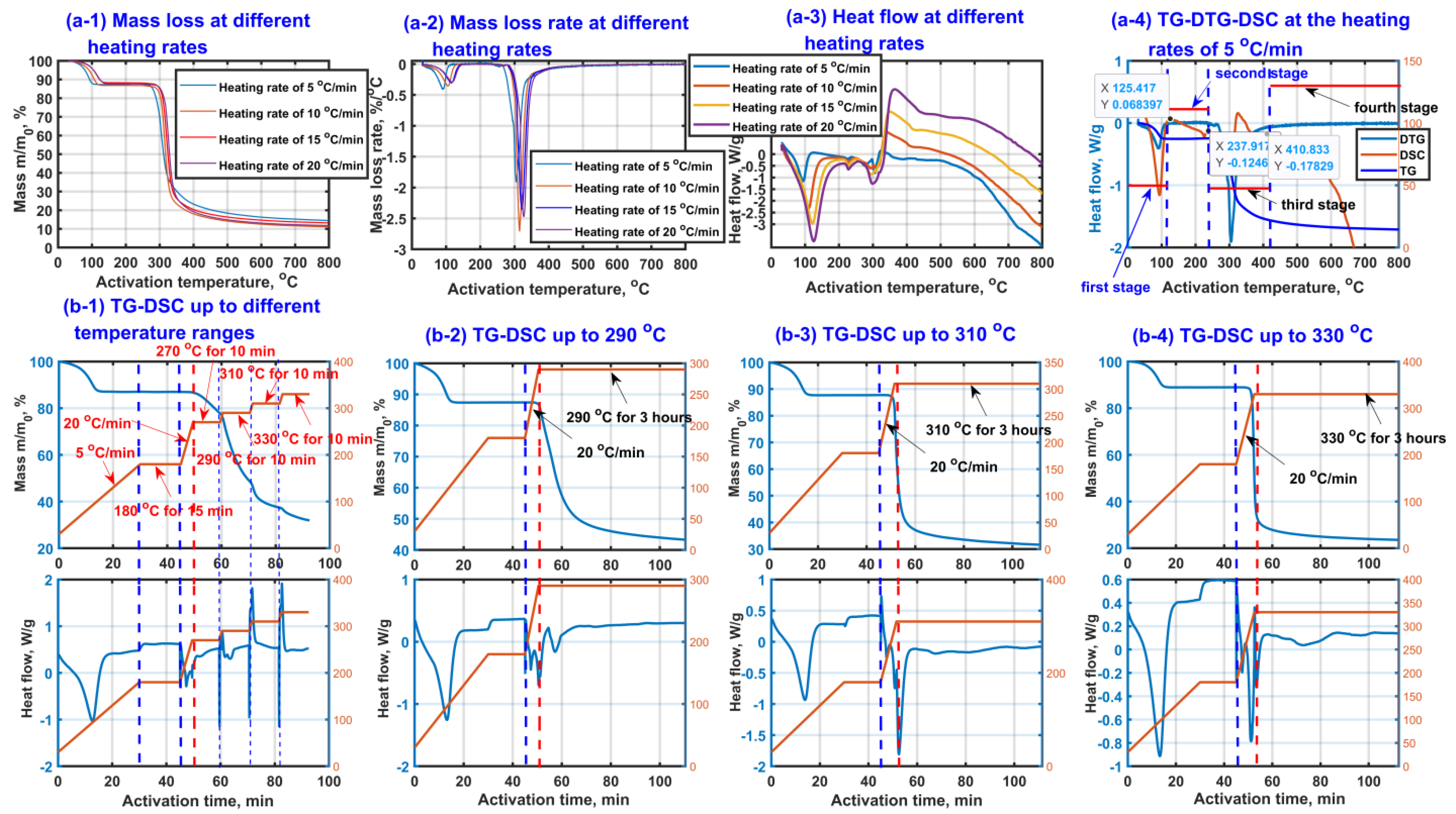
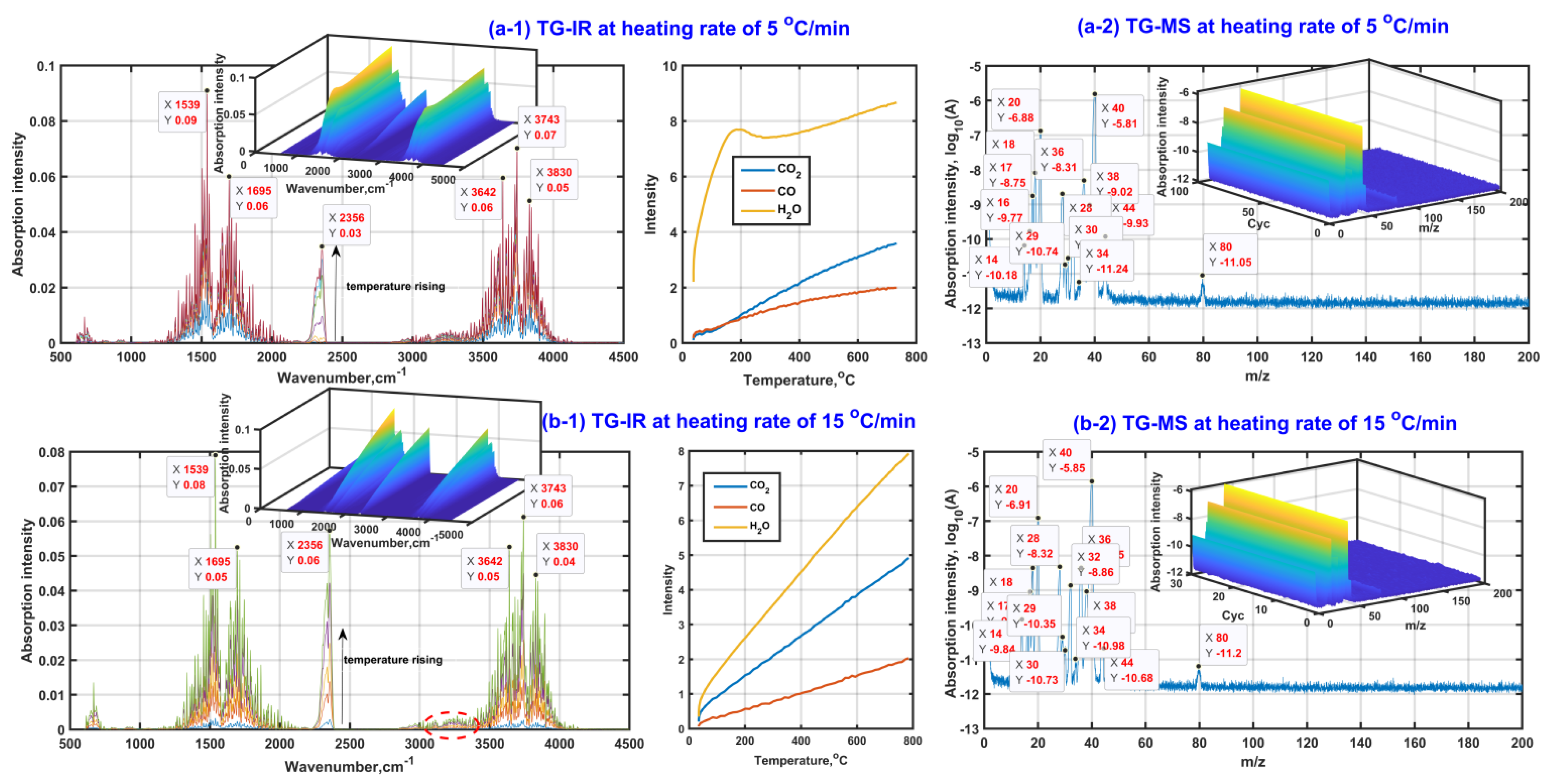
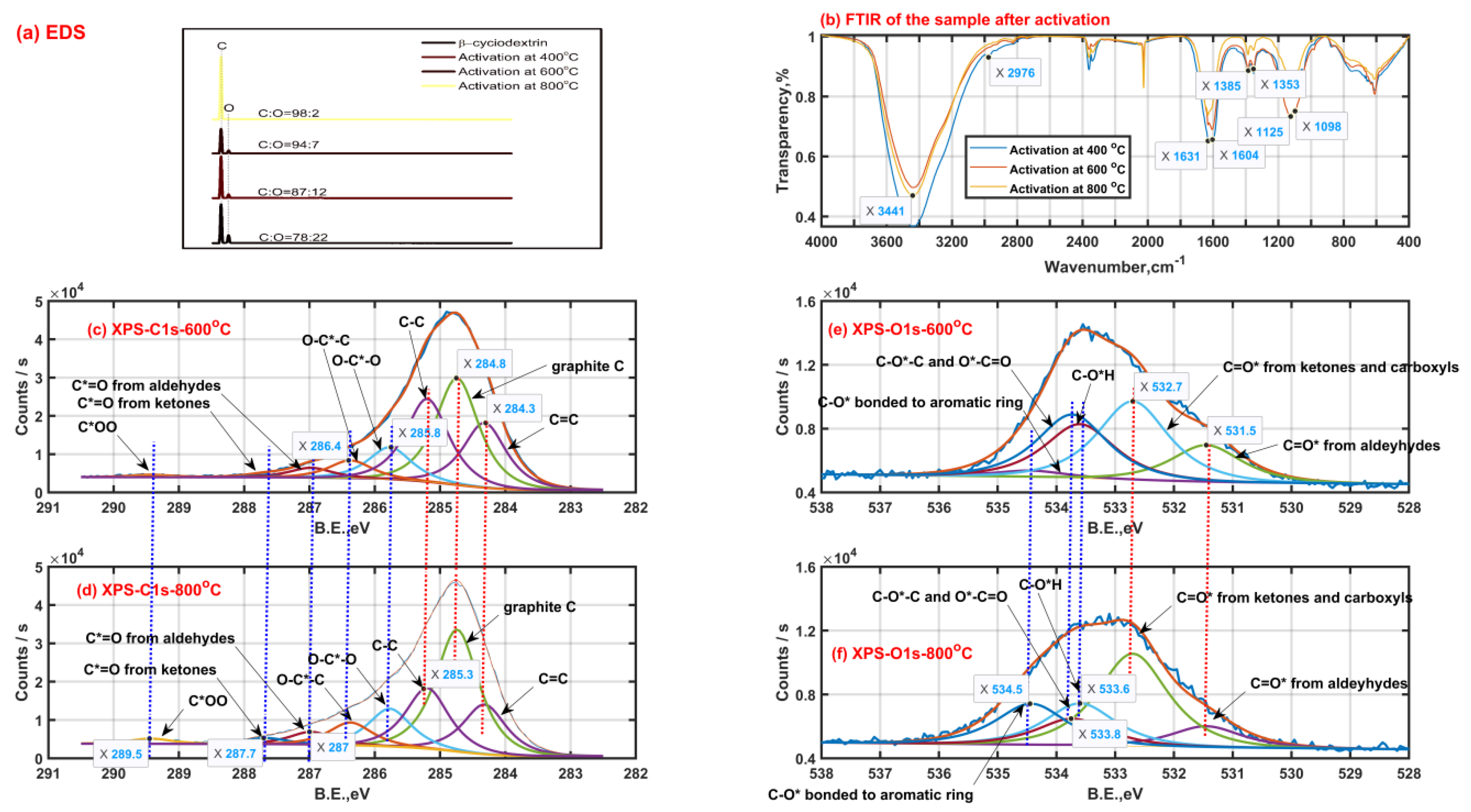
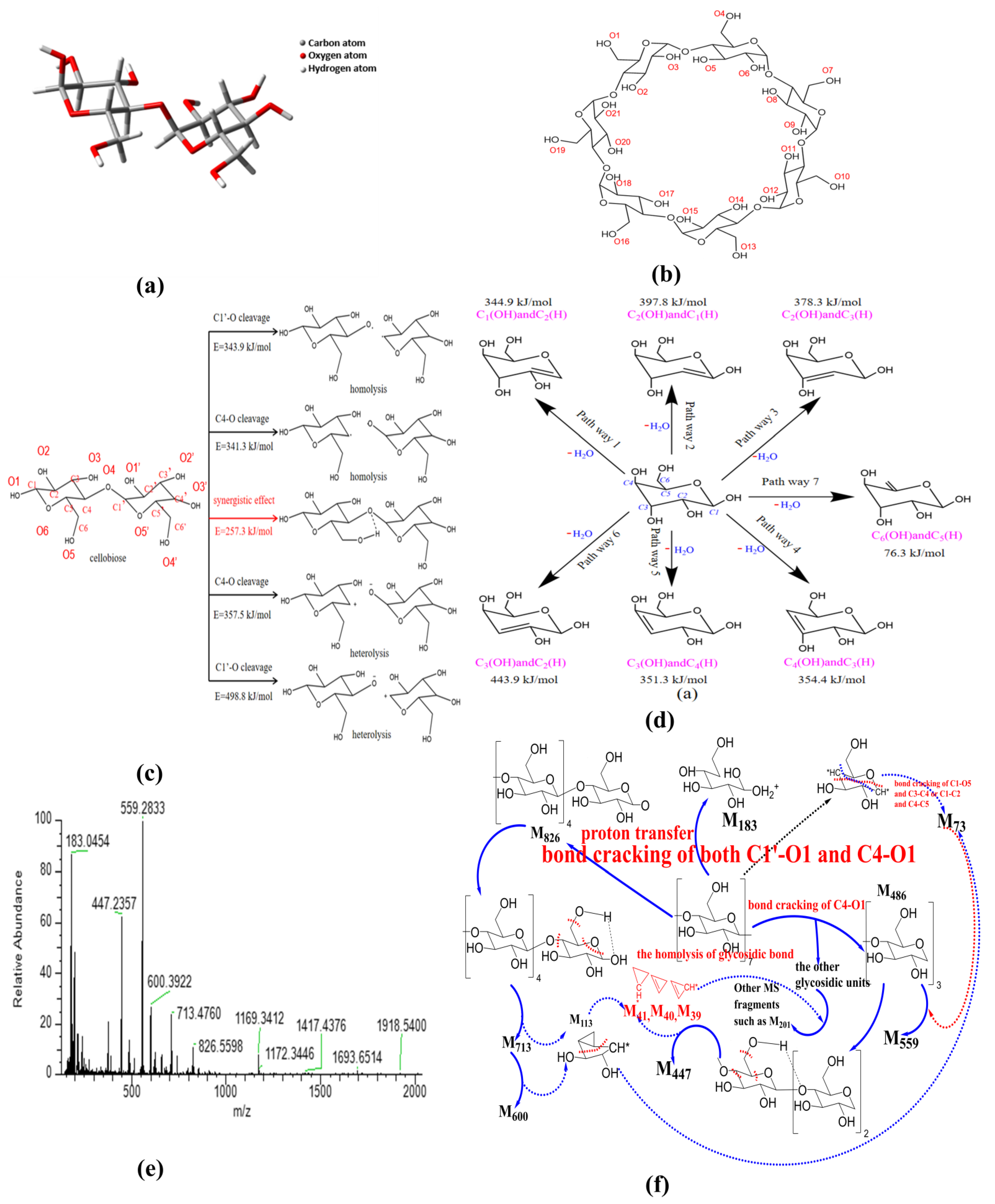
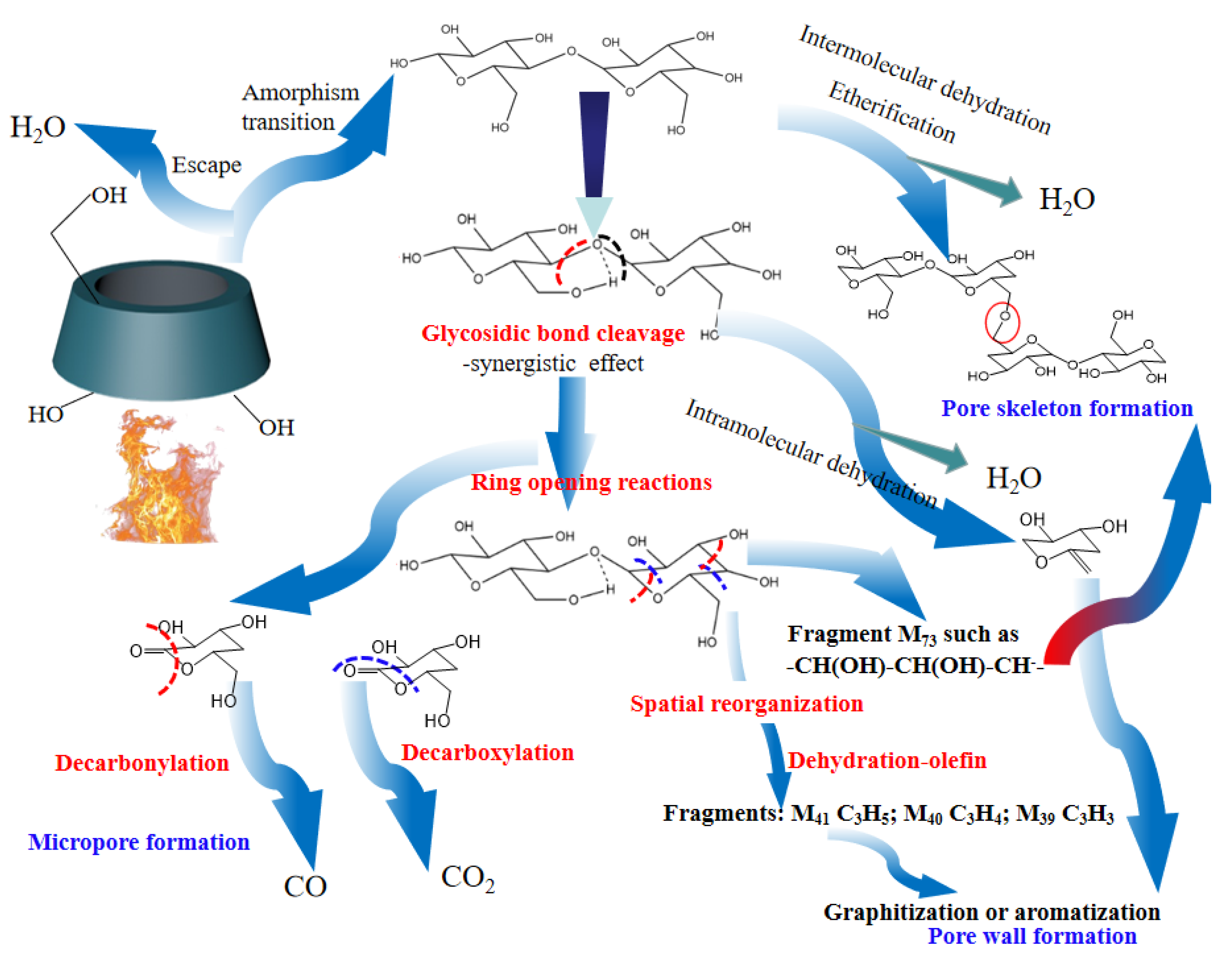


| Rate Constant, | Correlation Coefficient | Standard Deviation, | Rate Constant, | Correlation Coefficient | Standard Deviation, | ||
|---|---|---|---|---|---|---|---|
| 1.87 × 10−4 | 0.962 | 1.04 × 10−6 | 2.07 × 10−4 | 0.914 | 1.77 × 10−6 | ||
| 1.13 × 10−4 | 0.968 | 5.71 × 10−6 | 1.46 × 10−4 | 0.920 | 1.20 × 10−6 | ||
| 3.04 × 10−5 | 0.973 | 3.05 × 10−5 | 4.89 × 10−4 | 0.930 | 3.74 × 10−6 | ||
| 2.67 × 10−5 | 0.970 | 2.67 × 10−5 | 4.74 × 10−4 | 0.842 | 5.71 × 10−6 | ||
| 0.002 | 0.648 | 5.04 × 10−5 | 4.08 × 10−4 | 0.787 | 0.43 | ||
| 3.51 × 10−4 | 0.896 | 3.34 × 10−6 | 3.51 × 10−4 | 0.750 | 5.65 × 10−6 | ||
| Correlation coefficient | E (kJ/mol) 2 | E (kJ/mol) 3 | |||||
| 0.9873 | 99.1 | 102.7 | |||||
| 0.9904 | 104.7 | 106.4 | |||||
| 0.993 | 110.6 | 110.4 | |||||
| 0.9912 | 106.7 | 107.8 | |||||
| MS Peak, m/z | Intensity, log10(A) | Possible Ion Group Fragment | |
|---|---|---|---|
| 5 °C/min | 15 °C/min | ||
| 14 | −10.18 | −9.842 | –12CH2– |
| 16 | −9.772 | −9.871 | –16O– |
| 17 | −8.754 | −9.043 | –16OH |
| 18 | −8.085 | −8.355 | H216O(main), –18O–, –16OD |
| 20 (main, leading peak) | −6.876 | −6.91 | H2D16O+ and H218O, accompanied by H316O+, –18OD, HD16O |
| 28 with sub-peaks of 29 and 30 | −8.693 | −8.324 | 12C16O(main),12C2H4, accompanied by 13C16O, 12C13CH4, 12C2H3D, 12CH16O and 12C18O, 12CH216O |
| 32 | −9.143 | −8.862 | 16O2(main), 12CH218O |
| 36 with sub-peak of 34 | −8.307 | −8.354 | H16O18OH, accompanied by H216O2, 16O18O |
| 38 | −9.016 | −9.037 | –12C3H2– |
| 40 (main, leading peak) | −5.81 | −5.85 | 12C3H4(main), –12C213CH3, –12C3H2D, accompanied by –12C3H3, –12C213CH2–, –12C3HD– |
| 44 | −9.925 | −10.2 | 12C16O2(main), 12CH312CH16O |
| 80 | −11.05 | −11.2 | 12C6H8, 12C516OH4 |
| Item | Average Relative Mass | MS Observation | Difference | Possible Group Fragments |
|---|---|---|---|---|
| One glycosidic unit | 162 | 183 | 21 | e.g., one glycosidic unit containing one 13C atom, accompanied by one 16O atom at the location of C4 and the transfer of four protons |
| Two glycosidic units | 324 | 447 | M162–M39 | M39(*C3H3, cyclopropene radical) |
| Three glycosidic units | 486 | 559/600 | 73/113 | M73(e.g., –CH(OH)–CH(OH)–*CH– or –*CH–O–*CH–CH2–OH), M113(–CH(O)–CH(O)–CH–CH=CH–OH) |
| Four glycosidic units | 648 | 713 | M826–M113 | M40(C3H4, cyclopropene) |
| Five glycosidic units | 810 | 826 | 16 | M16–O |
| Six glycosidic units | 972 | |||
| Seven glycosidic units | 1134 | 1169 | 35 | isotope and –OH |
| Sample | Specific Surface Area (m2/g) | Total Pore Volume (cm3/g) | Pore Volume of Micropores (cm3/g) | Average Pore Size (nm) | Most Probable Pore Size (nm) |
|---|---|---|---|---|---|
| Original β-CD | 27.47 | 0.04 | 0.01 | 3.39 | 0.44 |
| β-CD derivative with the final activation temperature of 500 °C | 164.90 | 0.10 | 0.07 | 2.46 | 0.61 |
| β-CD derivative with the final activation temperature of 800 °C | 830.00 | 0.37 | 0.33 | 1.78 | 0.63 |
Publisher’s Note: MDPI stays neutral with regard to jurisdictional claims in published maps and institutional affiliations. |
© 2022 by the authors. Licensee MDPI, Basel, Switzerland. This article is an open access article distributed under the terms and conditions of the Creative Commons Attribution (CC BY) license (https://creativecommons.org/licenses/by/4.0/).
Share and Cite
Guo, T.; Zhang, R.; Wang, X.; Kong, L.; Xu, J.; Xiao, H.; Bedane, A.H. Porous Structure of β-Cyclodextrin for CO2 Capture: Structural Remodeling by Thermal Activation. Molecules 2022, 27, 7375. https://doi.org/10.3390/molecules27217375
Guo T, Zhang R, Wang X, Kong L, Xu J, Xiao H, Bedane AH. Porous Structure of β-Cyclodextrin for CO2 Capture: Structural Remodeling by Thermal Activation. Molecules. 2022; 27(21):7375. https://doi.org/10.3390/molecules27217375
Chicago/Turabian StyleGuo, Tianxiang, Runan Zhang, Xilai Wang, Lingfeng Kong, Junpeng Xu, Huining Xiao, and Alemayehu Hailu Bedane. 2022. "Porous Structure of β-Cyclodextrin for CO2 Capture: Structural Remodeling by Thermal Activation" Molecules 27, no. 21: 7375. https://doi.org/10.3390/molecules27217375
APA StyleGuo, T., Zhang, R., Wang, X., Kong, L., Xu, J., Xiao, H., & Bedane, A. H. (2022). Porous Structure of β-Cyclodextrin for CO2 Capture: Structural Remodeling by Thermal Activation. Molecules, 27(21), 7375. https://doi.org/10.3390/molecules27217375






